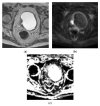Imaging and Management of Bladder Cancer
- PMID: 33808614
- PMCID: PMC8003397
- DOI: 10.3390/cancers13061396
Imaging and Management of Bladder Cancer
Abstract
Methods: Keyword searches of Medline, PubMed, and the Cochrane Library for manuscripts published in English, and searches of references cited in selected articles to identify additional relevant papers. Abstracts sponsored by various societies including the American Urological Association (AUA), European Association of Urology (EAU), and European Society for Medical Oncology (ESMO) were also searched.
Background: Bladder cancer is the sixth most common cancer in the United States, and one of the most expensive in terms of cancer care. The overwhelming majority are urothelial carcinomas, more often non-muscle invasive rather than muscle-invasive. Bladder cancer is usually diagnosed after work up for hematuria. While the workup for gross hematuria remains CT urography and cystoscopy, the workup for microscopic hematuria was recently updated in 2020 by the American Urologic Association with a more risk-based approach. Bladder cancer is confirmed and staged by transurethral resection of bladder tumor. One of the main goals in staging is determining the presence or absence of muscle invasion by tumor which has wide implications in regards to management and prognosis. CT urography is the main imaging technique in the workup of bladder cancer. There is growing interest in advanced imaging techniques such as multiparametric MRI for local staging, as well as standardized imaging and reporting system with the recently created Vesicle Imaging Reporting and Data System (VI-RADS). Therapies for bladder cancer are rapidly evolving with immune checkpoint inhibitors, particularly programmed death ligand 1 (PD-L1) and programmed cell death protein 1 (PD-1) inhibitors, as well as another class of immunotherapy called an antibody-drug conjugate which consists of a cytotoxic drug conjugated to monoclonal antibodies against a specific target.
Conclusion: Bladder cancer is a complex disease, and its management is evolving. Advances in therapy, understanding of the disease, and advanced imaging have ushered in a period of rapid change in the care of bladder cancer patients.
Keywords: CT; MRI; bladder cancer; imaging; management; urography; urothelial carcinoma.
Conflict of interest statement
The authors declare no conflict of interest.
Figures










References
-
- Galsky M.D., Hahn N.M., Rosenberg J., Sonpavde G., Hutson T., Oh W.K., Dreicer R., Vogelzang N., Sternberg C.N., Bajorin D.F., et al. Treatment of patients with metastatic urothelial cancer “unfit” for Cisplatin-based chemotherapy. J. Clin. Oncol. 2011;29:2432–2438. doi: 10.1200/JCO.2011.34.8433. - DOI - PubMed
-
- Al-Husseini M.J., Kunbaz A., Saad A.M., Santos J.V., Salahia S., Iqbal M., Alahdab F. Trends in the incidence and mortality of transitional cell carcinoma of the bladder for the last four decades in the USA: A SEER-based analysis. BMC Cancer. 2019;19:46. doi: 10.1186/s12885-019-5267-3. - DOI - PMC - PubMed
Publication types
LinkOut - more resources
Full Text Sources
Other Literature Sources
Research Materials

